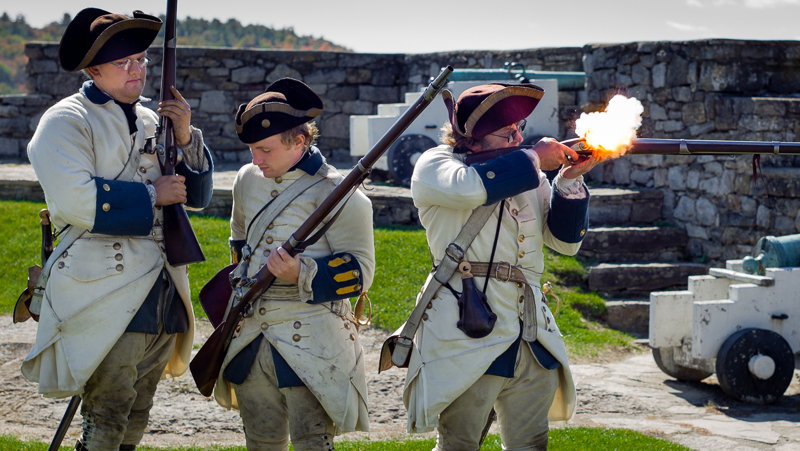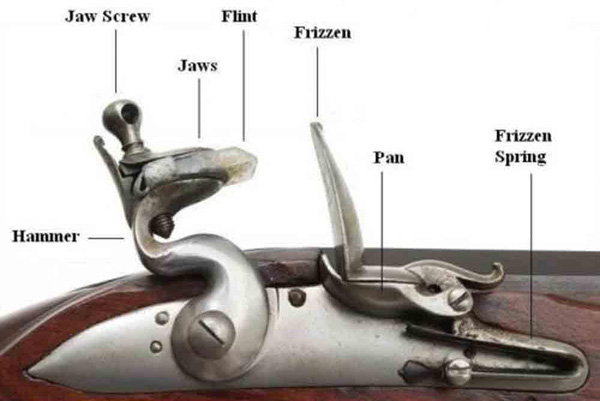Guest post by Jay Burleson
Jay Burleson, Flash in the Pan, 1756 French Infantry
Musket Demonstration, Fort Ticonderoga, New York
This photograph is, for several reasons, one of my favorites. Taken in 2015 with a Leica M9 and 75mm ƒ/2, the exposure, composition, and timing were all done well; the subjects are isolated from the background; and all three reenactors express varied and intriguing facial expressions. Most of all, you are seeing a demonstration of an extremely geeky process, frozen in the midst of happening—the firing of a flintlock musket. (Yes, referencing the recent TOP article, firearms aficionados also fit the definition of "geeks." Often right out to the extreme edge of the bell curve.)
The firearms pictured are modern reproductions of the French Charleville musket, first manufactured in 1717. Its production ended sometime during the 1840s. It was a .69 caliber smoothbore flintlock muzzle-loading musket used by French infantry forces around the world, including in many battles at and around Fort Ticonderoga in the mid-18th century. The flintlock mechanism was developed in the early 16th century and was pretty much the standard for firearms until the early 19th century.
The basic working of a flintlock is simple: the hammer, under spring tension, is holding a piece of flint, and when the trigger is pulled, the flint pivots forward forcefully and scrapes the flint against the frizzen or steel, resulting in a shower of sparks that ignites a small amount of black powder in the pan. From an engineering standpoint, the entire system is elegant in its robustness and simplicity.
When the black powder in the pan is ignited, some of the flame created by the burning powder enters a small hole, called the touch hole, drilled through the side of the barrel into the barrel's chamber, which subsequently ignites the main charge of powder in the barrel. The lead-ball projectile, which is seated into the barrel on top of the black powder, is then propelled out of the barrel.
If, under the stress of reloading your musket in a life-or-death situation, you forget to put a charge of black powder in the barrel, the flame from the pan has nothing to ignite, hence it's just a "flash in the pan." Most reference authorities agree that this—as illustrated in the photograph—is the origin of that phrase "flash in the pan," meaning "something which disappoints by failing to deliver anything of value, despite a showy beginning."
Despite my title, I do like to think that this photograph does deliver something of value, after its showy beginning!
Jay
Original contents copyright 2019 by Michael C. Johnston and/or the bylined author. All Rights Reserved. Links in this post may be to our affiliates; sales through affiliate links may benefit this site.
Amazon.com • Amazon UK • Amazon Canada
Amazon Germany • B&H Photo • Adorama
(To see all the comments, click on the "Comments" link below.)
Featured Comments from:
Keith: "An interesting side note regarding flintlocks; unlike the primer-based ignition in modern firearms, there is a noticeable delay between pulling the trigger and the actual firing of the gun, requiring a 'follow through' of maintaining the sights on target for an additional second after pulling the trigger. Failure to do so would yield a shot way off target. This delay earned the mechanism the alternative name of 'flinchlock,' because any flinching by the shooter is greatly exaggerated by the delay."
David Dyer-Bennet: "Very nice! Getting the priming charge so clearly is fairly rare."





My brother used black powder rifles for target shooting for a few years. He didn't use flintlocks though, but caps instead. I shot with one of his rifles once. I very nearly hit the bullseye at 100 yards with a 50 cal Minié ball. Mostly what I remember though is the soot on my face and clothes.
Posted by: Robert Roaldi | Wednesday, 21 August 2019 at 04:50 PM
Keep your powder dry!
Posted by: Rick Popham | Wednesday, 21 August 2019 at 07:32 PM
I always thought a "Flash in the Pan" was a cooking term.
some kind of flambe' thing.
But I degress....
When our forefounders wrote the 2nd Amendment they were talking about these "Arms".
Now AK-47's and others have different "Arms"
Try how to shoot 15 people in a store with those re-loading times?
Posted by: David Zivic | Wednesday, 21 August 2019 at 07:58 PM
The flintlock must have been interesting to fire after dark 8-0 Do-it-yourself flash blindness.
Impressive shot, the flash occurs before the bang—talk about a decisive moment!
Firearms, like cameras are just tools. In the US Army I fired carbines, rifles and a machine gun. I was responsible for the daily cleaning of these weapons—no geekery involved, it was part of my job description.
Hunters are like soldiers, it's just a job. If you live on a farm, there are varmints (an animal considered a pest; specifically : one classed as vermin and unprotected by game law) that need to be eliminated. Game hunters, hunt game for food or trophy—not because they are gun-geeks.
Posted by: c.d.embrey | Wednesday, 21 August 2019 at 10:48 PM
This is a very 'USA' post, GUNS ..., and the terminology has been continued in your use of words in photography. Getting the shot, this is a good shot, shooting some photos, firing a burst of shots ...
[Oh, pshaw. Many words have multiple meanings in English.
(Tennis match) That backhand was a spectaular shot!
(Argument) think you can convince me? Go ahead, take your best shot.
(Long day at the office) I think I'll just stay in tonight instead of going out to dinner. I'm shot.
(Movie) The opening shot lasts 7 minutes 47 seconds without an edit.
(Drinking) I'll have a shot of scotch.
(Track and Field) Now for the shot-put.
(The doctor's office) Time for your shot! Close your eyes and look the other way.
You can be just out of earshot, your efforts can be scattershot, if you found the problem you've troubleshot, if you drank too many of those shots of whiskey your eyes are bloodshot, if you summarize something you can give the upshot, if you're playing a snare drum you can hit a rimshot, if you think you're cool you're a hotshot.
Etc., etc. Referring to taking photographs as shooting and exposures as shots does not make it into a reference to guns. --Mike]
Posted by: Frank | Thursday, 22 August 2019 at 03:47 AM
The cloud of smoke and the flash of power gave away the shooters location with each shot. The time to reload... time for attackers to get close.
Lewis & Clark were remarkably trouble free with Indian tribes during their trip. This link may contain an explanation: https://www.youtube.com/watch?v=-pqFyKh-rUI as it details the 20 shot Air Rifle they had with them. 20 shots within 30 seconds - no smoke and no powder flash.
They did a shooting demonstration at each new tribal introduction. Not revealing they only had one of these Austrian Sniper rifles on the trip.
Technology that was worth the effort while today we have air rifles for everything from pest birds to Bison. Precision instruments with accuracy.
Posted by: Daniel | Thursday, 22 August 2019 at 09:15 AM
Is this considered flash photography?
Posted by: Kenneth Tanaka | Thursday, 22 August 2019 at 10:24 AM
Mike, so glad to see you didn’t let Frank get away with that cheap shot.
Posted by: Ned Bunnell | Thursday, 22 August 2019 at 11:31 AM
Mike, in your long reply to Frank’s comment you left out that shot and shoot refers strictly to archery rather than firearms ;-)
Posted by: Richard Parkin | Thursday, 22 August 2019 at 02:10 PM
Brandon in Suffolk, England was a world centre because of the quality of the flints. So much so that both sides in the Napoleonic Wars used flints knapped at Brandon.
Posted by: David Bennett | Thursday, 22 August 2019 at 03:47 PM
Sometimes you miss it...

...and sometimes get lucky

Both pics from Fort Henry, Ontario (not sure of the exact specs of the cannon but taken some years ago on slide film with a Nikon!)
Posted by: David Elden | Thursday, 22 August 2019 at 10:34 PM
I have long believed that “ flash in the pan” was a photographic reference, to the long ago practice of igniting magnesium powder in a metal pan, in the first form of flash photography.
David
[Most sources say it dates from the late 16th century, well before photography. But I've only looked online, so I don't know how authoritative the sources are. --Mike]
Posted by: David | Thursday, 22 August 2019 at 10:59 PM
Heh, Left Coast U.S. bias perhaps showing but I had thought flash in the pan referred to a gold flake being spotted in their pan by a hopeful placer mining prospector.
We have enough theories to start a flash mob.
Posted by: Rick_D | Friday, 23 August 2019 at 09:33 PM
"Shot-put" competition in track and field does I believe derive from firearms terminology -- the metal spheres they throw look very much like the iron cannon balls used for a long time (in various sizes), up through some of the 19th century.
Posted by: David Dyer-Bennet | Saturday, 24 August 2019 at 06:14 PM
Some of the very best sources are online—like the Oxford English Dictionary, widely accepted as the ultimate authority on English etymology. (Luckily for me, I have access to their online service through my public libraries website.)
And they seem to first cite "flash in the pan" to the early 18th century (so still safely before photography), and it does appear to be the specific firearms usage we're discussing:
1705 tr. W. Bosman New Descr. Coast of Guinea xvii. 318 Missing his shot by a flash in the Pan.
Posted by: David Dyer-Bennet | Saturday, 24 August 2019 at 06:22 PM
From the Oxford English Dictionary (a reasonably authoritative source):
c. to flash in the pan: literal said of a gun, when the priming powder is kindled without igniting the charge; figurative to fail after a showy effort, to fail to ‘go off’.
1687 E. Settle Refl. Dryden's Plays 20 If Cannons were so well bred in his Metaphor as only to flash in the Pan, I dare lay an even wager that Mr. Dryden durst venture to Sea.
1736 Compl. Family-piece ii. i. 243 It will occasion it oft-times to flash in the Pan a great while before it goeth off.
1792 G. Morris in J. Sparks Life G. Morris (1832) I. 377 Their majesties flashed in the pan yesterday.
1830 J. Galt Lawrie Todd I. iii. ix. 244 Flashing in the pan scares ducks.
1852 W. Jerdan Autobiogr. IV. xiii. 237 Cannon attempted a joke which flashed in the pan.
Posted by: Gene Spesard | Sunday, 25 August 2019 at 11:30 PM